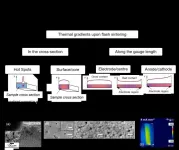(Press-News.org) Researchers have demonstrated that a slimy, yet tough, type of biofilm that certain bacteria make for protection and to help them move around can also be used to separate water and oil. The material may be useful for applications such as cleaning contaminated waters.
In the journal Langmuir, North Carolina State University researchers reported the findings of an experiment in which they used a material produced by the bacteria Gluconacetobacter hansenii as a filter to separate water from an oil mixture.
"It's really remarkable to think that these little bugs can make this stuff that is so perfect in many ways," said Lucian Lucia, the study's corresponding author and an associate professor of forest biomaterials and chemistry at NC State.
The biofilm the bacteria make and release into their environment is made of cellulose, which is the same material that gives plants a sturdy structure in their cell walls. However, when bacteria make cellulose, it has a tightly packed, crystalline structure, researchers said.
"It's one of the purest, if not the purest, forms of cellulose out there," Lucia said. "It's very well structured. It's very water loving, and it's got a very high crystallinity, so it packs very beautifully. Once you strip out the bacteria, you have this amazingly tough material that has a real robustness, or toughness."
The bacteria make the film to protect themselves, the researchers said.
"If you leave something like an unwashed dish out, it can turn all slimy and gross - that's a biofilm," said study co-author Wendy Krause, associate professor of textile engineering, chemistry and science at NC State. "Different bacteria make different biofilms. The bacterial film that we're studying is made of cellulose. The bacteria are making it because they live on it and in it. They're making their home."
In the experiment, researchers used the bacteria as factories of cellulose nano-fibers. They then removed the bacteria and their non-cellulose residue. Finally, the researchers used the cellulose membrane to see if it could separate water from a solution containing both oil and water.
They found the material was effective at removing water, and it was sturdy.
"The oil doesn't want to go through the membrane; it has a repulsive effect to it," Lucia said. "It's super fat-hating."
"If the oil and water were highly mixed, it doesn't matter," Krause added. "You could put an immersion blender into the solution, and the membrane will still separate the water and oil."
Researchers see a variety of potential applications for the material in situations where you need to recover water from an oily mixture - whether it be to clean water contaminated with a textile dye or for environmental remediation. In future work, the researchers want to explore how they can tailor the membrane by chemically modifying it for certain applications.
The study, "Bacterial Superoleophobic Fibrous Matrices: A Naturally Occurring Liquid-Infused System for Oil-Water Separation," was published online in the journal Langmuir on Feb. 19.
INFORMATION:
Note to editors: The abstract follows.
"Bacterial Superoleophobic Fibrous Matrices: A Naturally Occurring Liquid-Infused System for Oil-Water Separation."
Published online in Langmuir on Feb. 19, 2021.
Authors: Zahra Ashrafi, Zimu Hu, Lucia Lucia and Wendy Krause.
DOI: 10.1021/acs.langmuir.0c02717
Abstract: Nanocellulose fibers bioengineered by bacteria are a high performance three-dimensional cross-linked network which can confine a dispersed liquid medium such as water. The strong chemical and physical interactions of dispersed water molecules with the entangled cellulosic network allow these materials to be ideal substrates for effective liquid separation. This type of phenomenon can be characterized as green with no equivalent precedent; its performance and sustainability relative to other cellulose-based or synthetic membranes are shown herein to be superior. In this work, we demonstrated that the renewable bacterial nanocellulosic membrane can be used as a stable liquid-infused system for the development of soft surfaces with superwettability and special adhesion properties and thus address intractable issues normally encountered by solid surfaces.
Flash sintering is a ceramic processing technique which uses electric current to intensively heat the ceramic sample internally rather than using only external furnace heating. The process can lower ceramic processing temperatures and durations significantly, enabling ceramics to be co-processed with metals or other materials, and reducing energy use.
However, the process can result in low quality ceramics due to weaknesses caused by inhomogeneities in the microstructure.
The origins of these inhomogeneities caused by thermal gradients in the material during flash sintering have been studied by researchers ...
Deforestation may cause an initial increase in malaria infections across Southeast Asia before leading to later decreases, a study published today in eLife suggests.
The results may help malaria control programs in the region develop better strategies for eliminating malaria infections and educating residents on how to protect themselves from infection.
Mosquitos spread the malaria parasite to humans causing infections that can be severe and sometimes deadly. In the area along the Mekong river in Southeast Asia, many residents hunt or harvest wood in the surrounding forests, which can increase their risk of infection. Yet recent outbreaks of malaria in the region have also been linked to deforestation.
"As countries in the region focus their malaria control ...
As the fight against COVID-19 continues, scientists have turned to an unlikely source for a potentially effective treatment: tiny antibodies naturally generated by llamas.
While the world has welcomed the news of multiple vaccines against COVID-19, the search for effective treatments for those who contract the virus is ongoing. Now scientists are looking to what might seem to be an unlikely source: the South American llama.
Researchers are using the ultrabright X-rays of the Advanced Photon Source (APS), a U.S. Department of Energy (DOE) Office of Science User Facility at DOE's Argonne National Laboratory, to help turn naturally generated llama antibodies into potentially effective therapies against ...
Every 12 minutes, someone in the United States dies of pancreatic cancer, which is often diagnosed late, spreads rapidly and has a five-year survival rate at approximately 10 percent. Treatment may involve radiation, surgery and chemotherapy, though often the cancer becomes resistant to drugs.
Researchers at University of California San Diego School of Medicine and Moores Cancer Center, in collaboration with Sanford-Burnham-Prebys Medical Discovery Institute and Columbia University, demonstrated that a new tumor-penetrating therapy, tested in animal models, may enhance the effects of chemotherapy, reduce metastasis ...
Computational models of air quality have long been used to shed light on pollution control efforts in the United States and Europe, but the tools have not found widespread adoption in Latin America. New work from North Carolina State University and Universidad de La Salle demonstrates how these models can be adapted to offer practical insights into air quality challenges in the Americas outside the U.S.
Computational air quality models can be used in multiple ways. For example, they can be used to determine which sources are responsible for what fraction of air pollution. They can also help authorities predict how air pollution might change if different pollution control methods are adopted.
"Historically, it's been very challenging to apply these modeling ...
Polymer scientists from the University of Groningen and NHL Stenden University of Applied Sciences, both in the Netherlands, have developed a polymer membrane from biobased malic acid. It is a superamphiphilic vitrimer epoxy resin membrane that can be used to separate water and oil. This membrane is fully recyclable. When the pores are blocked by foulants, it can be depolymerized, cleaned and subsequently pressed into a new membrane. A paper describing the creation of this membrane was published in the journal Advanced Materials on 7 March 2021.
How do you clean up an oil spill in ...
Study Reveals New Hope for Men With Common Urinary Issues
A new systematic review of evidence recommends the use of behavioral self-management treatments for common urinary issues experienced by upwards of 70 percent of older men. Common symptoms include trouble urinating, increased frequency and incontinence. These symptoms can have a substantial negative impact on sleep, social functioning and quality of life. Several guidelines recommend self-management techniques like health education, advice on fluid intake, and bladder retraining; however, in practice, self-management is often excluded from the menu of treatment options that include medication and surgery.
Researchers at Bond University's Institute for Evidence-Based Healthcare found that ...
What would a truly progressive city look like? A city that pays more than lip service to issues that directly affect low-income residents, seniors, marginalized communities and others whom neoliberal policies have seemingly left behind? ...
Since 1983, the bacteria Pantoea ananatis has been known to infect several important crops including onions, rice, and corn. It was unclear, however, what molecules were involved. A new study, published in mBio, has identified one of the culprits: pantaphos. Intriguingly, the researchers have discovered that pantaphos can also act as an herbicide and it is toxic to glioblastoma cells, making it an exciting candidate for agricultural and biomedical applications.
"Herbicide resistant weeds are an issue in agriculture," said William Metcalf (MMG leader), a professor of microbiology. "Unfortunately, there hasn't been a new class of herbicide ...
CHAPEL HILL, NC -- A comprehensive review by University of North Carolina researchers and colleagues of hundreds of publications, incorporating more than two dozen articles on prevention screening for lung cancer with low-dose spiral computed tomography (LDCT), shows there are both benefits and harms from screening. The review is published in JAMA on March 9, 2021.
The results of the decadelong National Lung Screening Trial (NLST) showed that LDCT could detect lung cancer better than conventional X-rays in current or previous heavy smokers. Based on those results, the United States Preventive Services ...






